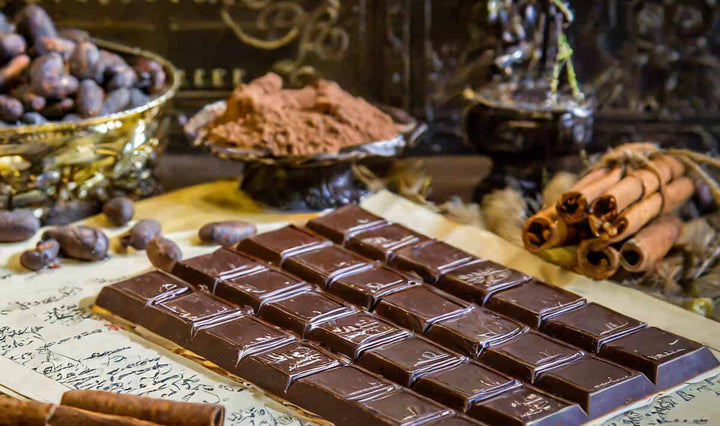In the realm of romantic gestures, few things are as quintessentially symbolic as the heart-shaped chocolate box, a staple of Valentine’s Day and a universal emblem of love and affection.
In this post, we look into the history of who invented the first heart-shaped chocolate box, tracing its journey from a novel idea to a beloved symbol of romance.
We will explore the ingenuity and vision behind this creation, transforming how we express love and revolutionising the chocolate industry.
Who Invented the First Heart-Shaped Chocolate Box?
Richard Cadbury, a member of the second generation of the Cadbury chocolate manufacturing family in England, made a significant contribution to the chocolate industry and the celebration of Valentine's Day in the late 19th century.
During the Victorian era, which saw a surge in the popularity of Valentine's Day and the exchange of gifts and cards, Richard Cadbury seized the opportunity to innovate in the realm of confectionery packaging.
In 1861, he introduced the first heart-shaped chocolate box, a design he crafted adorned with cupids and rosebuds.
This box was not just a container for chocolates but was intended to be a keepsake or trinket box, adding sentimental value to the gift.
This innovative packaging transformed how chocolates were presented and gifted on Valentine's Day.
It popularized the act of giving chocolates as a romantic gesture and elevated the status of the chocolate box to that of a cherished and sentimental gift.
The legacy of Richard Cadbury's heart-shaped chocolate box continues today, becoming a symbol of Valentine's Day and romantic gifting worldwide.
His creativity and vision in intertwining romance, indulgence, and thoughtful gifting have had a lasting impact, making the heart-shaped chocolate box a staple globally for Valentine's Day celebrations.
The heart-shaped chocolate box is a testament to Richard Cadbury's innovative spirit, forever changing the chocolate industry and the way we express affection with sweets.

Why Do We Give Chocolate On Valentine’s Day?
Giving chocolate on Valentine's Day is a tradition that has evolved over time, blending cultural, historical, and commercial influences.
This practice is deeply rooted in the historical association of chocolate with love and luxury, making it a popular gift for this romantic occasion.
-
Historical Romance of Chocolate: Chocolate's reputation as an aphrodisiac dates back to the Aztecs. It was believed to possess qualities that incited passion and love, a belief that persisted into the European chocolate houses of the 17th and 18th centuries. Chocolate's luxurious and indulgent nature made it a symbol of desire and affection.
-
Victorian Era and the Art of Courtship: In the Victorian era, the courtship rituals were intricate, with gifts playing a key role. The introduction of chocolate as a fine delicacy during this period made it a fashionable and desirable gift, especially among the social elite.
-
Richard Cadbury and the Heart-Shaped Box: The invention of the heart-shaped chocolate box by Richard Cadbury in the 19th century cemented the association of chocolate with Valentine's Day. These boxes were not just containers for chocolates; they were ornate and decorative, doubling as keepsakes.
-
Chocolate's Sensory Appeal: The sensory experience of chocolate – its richness, the way it melts in the mouth – is often likened to the sensations of being in love. This makes chocolate a fitting metaphor for romance and sensuality.
-
Commercial Promotion: The 20th century saw a significant commercialization of Valentine's Day, with chocolate companies capitalising on the holiday. Extensive marketing campaigns reinforced the idea of chocolate being synonymous with romantic love.
-
Versatility and Accessibility: Today, the variety of chocolates makes it a versatile gift option, suitable for different tastes and budgets. From luxury artisanal chocolates to classic favourites, there is a type of chocolate for every expression of love.
The tradition of giving chocolate on Valentine's Day is deeply interwoven with cultural perceptions of love, luxury, and indulgence.
Over time, it has become a conventional yet cherished way to express romantic feelings and celebrate love.
What is the History of Valentine's Day?
Valentine's Day, celebrated on February 14th, has a rich and complex history spaning centuries and cultures.
Dedicated to love and affection, this day has evolved from ancient rituals to the modern-day global celebration of love.
-
Ancient Roman Origins: The origins of Valentine's Day can be traced back to the ancient Roman festival of Lupercalia, celebrated in mid-February. Lupercalia was a fertility festival dedicated to Faunus, the Roman god of agriculture, and to Romulus and Remus, the founders of Rome. The festival included unique rituals and was believed to protect from evil spirits and purify the city, releasing health and fertility.
-
St. Valentine(s) and Christian Influence: As Christianity spread, the pagan festival was Christianized. The day gets its name from St. Valentine, but there's ambiguity as there were several Christian martyrs named Valentine. The most popular legend is that of a priest named Valentine who secretly married couples in defiance of Emperor Claudius II in Rome, who had banned marriage for young men. Valentine was eventually martyred for his actions.
-
Chaucer and the Romantic Association: The romantic nature of Valentine's Day might have been popularised by Geoffrey Chaucer, the English poet, in the 14th century. Chaucer wrote poems associating Valentine's Day with romantic love, fitting with the courtly love tradition of the Middle Ages.
-
Evolution of Traditions: By the 18th century, Valentine's Day had evolved into an occasion where lovers expressed affection for each other with flowers, sweets, and greeting cards (known as "valentines"). The tradition of handwritten notes gave way to mass-produced greeting cards in the 19th century.
-
Commercialization and Global Spread: The 20th century saw the commercialization of Valentine's Day, especially in the United States and the UK, with the promotion of chocolates, jewellery, and flowers as gifts. This commercial aspect led to the global spread of Valentine's Day, making it a significant cultural and economic event.
Valentine's Day has transformed from an ancient fertility festival to a day celebrating romantic love, which is marked by exchanging cards, gifts, and gestures.
This evolution reflects broader changes in cultural and social practices related to love and relationships.

Where Can You Buy Heart-Shaped Chocolates?
For a delightful selection of heart-shaped chocolates perfect for Valentine's Day, look no further than Whitakers Chocolates.
Our milk chocolate-shaped foiled hearts are an ideal gift for this romantic occasion.
Additionally, Whitakers offers a wide variety of Valentine 's-themed gift boxes filled with luxury chocolate truffles, catering to all tastes and preferences for that special someone.
Check out the full Valentine's Day range here:
Some Notes From an Expert Chocolatier
As an expert chocolatier, I've always been fascinated by the deep connection between chocolate and romance.
Crafting chocolates, especially for occasions like Valentine's Day, is not just about creating a sweet treat; it's about understanding and encapsulating the essence of love and affection in every bite.
Chocolate, with its rich, complex flavours and melt-in-the-mouth texture, naturally evokes feelings of warmth and happiness, making it a perfect medium to express romantic sentiments.
Selecting the finest ingredients and carefully shaping them into exquisite confections is a labour of love in itself, mirroring the thoughtfulness and care of choosing a gift for a loved one.
This beautiful synergy between chocolate and romance makes being a chocolatier especially rewarding during the season of love.
Final Notes On the Invention of Heart-Shaped Chocolate Boxes
The invention of the first heart-shaped chocolate box by Richard Cadbury in the 19th century stands as a testament to both innovation and the enduring appeal of romance.
This creation revolutionised the chocolate industry and firmly established the heart-shaped box as a symbol of love and affection.
Cadbury's ingenuity in combining exquisite chocolates with ornate and reusable packaging captured the essence of Valentine's Day, making the act of giving chocolates a more meaningful and sentimental gesture.
Today, the heart-shaped chocolate box remains a beloved tradition, symbolising love's timeless and universal language.
Richard Cadbury's contribution extends beyond confectionery; it's woven into the fabric of how we express and celebrate love, making it an enduring part of romantic culture and heritage.











